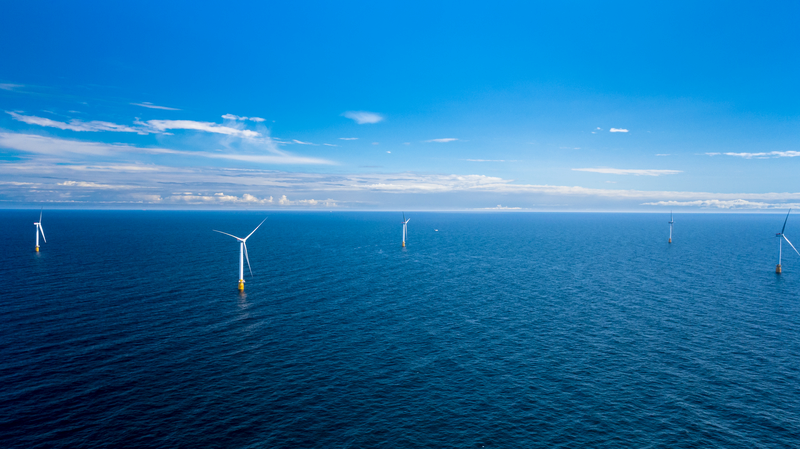
Back in 2017, the world’s first floating offshore wind farm, a 30MW demonstration project, was installed off the east coast of Scotland.
Five years on, the UK is targeting 5GW of floating offshore wind by 2030, which is equal to half its current total offshore wind capacity. In the recent ScotWind offshore wind leasing round – the world’s first fully commercial leasing round to support large-scale floating wind – the technology was awarded 14.5GW out of a total 25GW. The Crown Estate is planning a further 4GW of leasing for floating wind in the Celtic Sea.
Five years ago, floating offshore wind was seen as potentially interesting and able to play a role in the UK’s renewable energy mix, says Rhys Wyn Jones, director of RenewableUK Cymru, the Wales branch of trade association RenewableUK. “It is now seen as absolutely central to offshore renewables’ contribution to the energy transition between now and 2050. We are on the cusp, and I think ScotWind puts rocket boosters underneath floating wind.”
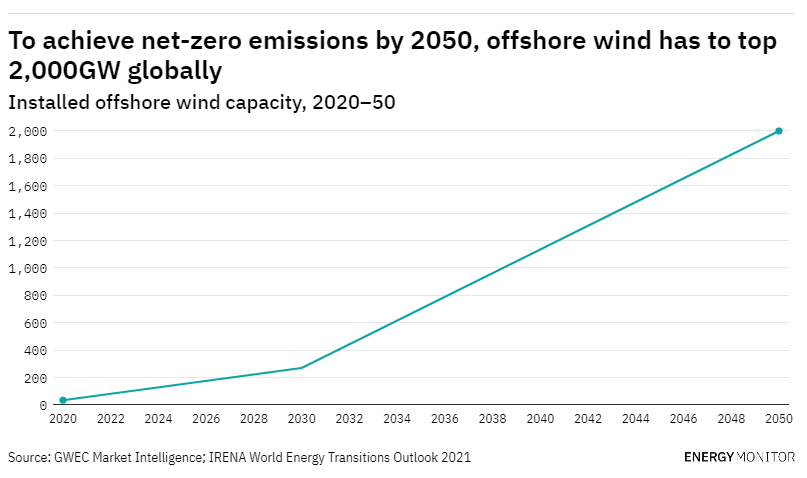
So how close is floating offshore wind really to providing a significant chunk of the UK’s – and the world’s – electricity and what are the hurdles it still has to overcome to get there?
A flexible technology to access new waters
Floating offshore wind is similar to conventional offshore wind in many respects, in that the wind turbines essentially work in the same way. However, instead of being locked to the seabed floor via a fixed structure, it uses floating platforms anchored to the seabed using mooring chains.
A variety of platform designs have been developed, with barge, semi-submersible, spar, and tension-leg platforms the most prevalent. Stefanie Bourne, renewables and offshore wind director at Norwegian consultancy DNV, says she often gets asked whether they will not simply tip over. “The answer is no, we are designing them specifically so that they won't. It is an engineering challenge, but that is all it is: it is not an impossible challenge.”
Floating wind offers several advantages over conventional fixed-bottom offshore wind, the most obvious of which is that floating turbines can be located in seabed depths of several hundred metres, compared with a maximum of around 65m for fixed-bottom. This allows far more flexibility in where it is put. Offshore wind can already access higher wind speeds than onshore, but this allows floating wind to take advantage of the very best spots.
“The fact that you can operate floating wind in much deeper waters gives you access to a far larger resource,” says Wyn Jones. "Stronger winds out in deeper waters have a huge benefit.”
In places where water gets deep quickly off the coast, such as California and Japan, floating wind could also be the key to installing offshore wind relatively near where electricity is needed. In the UK, which is relatively well-endowed with suitable sites for fixed-bottom wind, a key argument for floating wind is the ability to install it further off the coast, says Sam Strivens, who manages the Floating Wind Joint Industry Project, a research and development initiative run by the Carbon Trust, a consultancy, to support the deployment of commercial floating wind.
“One of the key challenges [of the UK’s target to install 50GW of offshore wind by 2030] is, where do we actually put all these turbines?,” says Strivens. “There is also our fishing industry, there is the wildlife and environmental implications, there is the military, there is shipping and transportation. It is quite a crowded space already.”
Floating offshore also gives more opportunities for asynchronous generation, notes Wyn Jones, with a larger spread of renewables meaning it is more likely the wind will be blowing somewhere. “[For example], we don't really have that fixed-bottom wind presence in the Celtic Sea,” he says. “Floating wind opens that part of the seabed up to renewable generation. This could act as a hedge against times of low generation elsewhere.”
A report from ORE Catapult last year found that floating wind could deliver £43.6bn in UK gross value add by 2050, creating more than 29,000 jobs in the process – in return for £2.2bn in support in the early stages of development. Scotland, North East England, and the Celtic Sea are the most appropriate areas for cost-effective, large-scale deployment, it said.
Costs could halve by 2025
The main challenge to floating offshore wind remains the need to reduce costs, says DNV’s Bourne. The first floating wind farms saw a levelised cost of energy exceeding $200 per megawatt hour (MWh), according to DNV, compared with $50/MWh for fixed-bottom offshore wind currently. Government incentives and targets to build full utility-scale floating wind farms are needed to bring down costs, says Bourne.
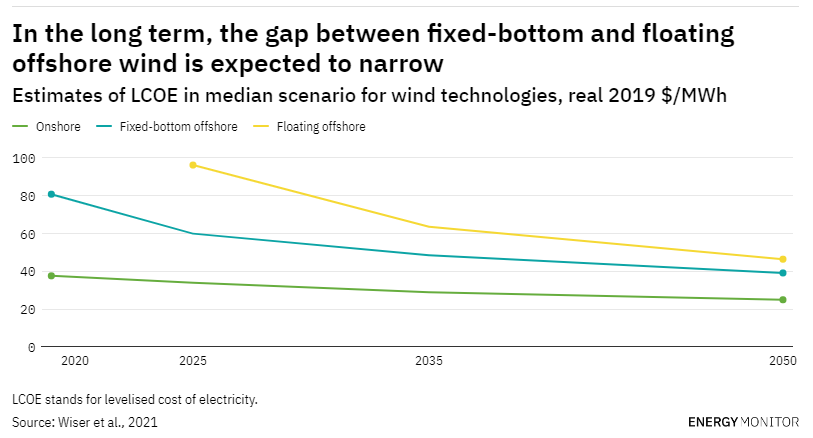
Hywind Tampen, an 88MW floating wind project currently under construction in Norway, is set to be the world’s largest floating offshore wind farm when it comes online later this year to deliver electricity to oil and gas platforms. According to Equinor, it is on track to reduce costs for the farm by more than 40% compared with the 2017 Hywind Scotland demonstrator.
DNV estimates that the cost of floating offshore wind could drop to below $100/MWh by 2025 and $40/MWh in 2050. Floating offshore wind could be “subsidy free” in the UK by 2030, according to ORE Catapult, which notes that the cost of floating wind is coming down faster than it did for fixed-bottom wind.
Bourne says that floating wind will likely never reach complete cost parity with fixed-bottom wind, due to the nature of the moorings, floaters, and cabling that is needed. “[Floating wind will] always be slightly more expensive than a fixed-bottom project, but not by much,” she says. “It is not going to be at a level that is going to detract investment from it.”
The prevalence of floating offshore wind in the ScotWind leasing round, as well as the government’s new 5GW target, marks a step change for floating wind as it moves to commercial scale.
“It is a completely different landscape now,” says Strivens. “When Hywind went in [...] it was still very much about de-risking the technology. Now, floating offshore wind is being seen [in the UK] as an established energy source alongside fixed-bottom offshore wind.”
While initial demonstration projects have tended to be financed off the balance sheets of energy majors such as Equinor, installations due to go into the water in the next year or so are being financed by capital finance, he notes. “The next stage is actually commercialisation or industrialisation. How do you build 100 floating platforms off the coast of Scotland?”
Bourne says that it is unlikely all the ScotWind floating projects will be in the sea by 2030. “They are all kind of past the first hurdle,” she says. “Sadly, of course, they have many, many more hurdles to clear before they can get into the water.”
However, floating offshore wind is now at a different stage of development to some of the other low-carbon technologies being researched off the UK coast, such as wave and tidal power.
“What we are doing is effectively taking fixed-bottom turbines that are very well demonstrated and putting them on platforms we have been using in oil and gas for the past 40–50 years,” says Strivens. “The risk hurdles aren't quite the same, in terms of technical risk and confidence, as for wave and tidal, which are really properly novel technologies.”
Grids, port and supply chain hurdles
The logistics of installing large-scale floating offshore wind farms is a huge challenge, however. There are several hurdles.
One of the biggest is related to the grid, says Bourne. “Right now, we literally could not connect all of the projects to the grid in the UK, there is not enough capacity,” she says. The upcoming Offshore Transmission Network Review should help address this, but concern over grid connections is one reason why many projects are proposing to turn their electricity into green hydrogen, says Bourne.
Getting enough projects in the water in time to hit the 5GW 2030 target will be challenging, she adds. The government has already said it will reduce the consenting and permitting time from up to four years to one year, but other parts of the development process also need to be compressed, she suggests.
Installing the projects will also present major challenges to other UK infrastructure. Some harbours and ports are not deep enough to allow floating wind turbines to pass through them, for example. Ports may need retrofits to change that. Developing UK sites to build the huge turbines as close as possible to where they will be installed is another challenge. And the huge amounts of steel and concrete needed is yet another: floating wind turbines can require double the amount of steel as a fixed-bottom turbine of equivalent size, according to DNV.
The skills challenge for such a scale-up is also massively overlooked, says Bourne. “We have been a small renewables industry for 20 or 30 years. We need so many more people than we actually have.”
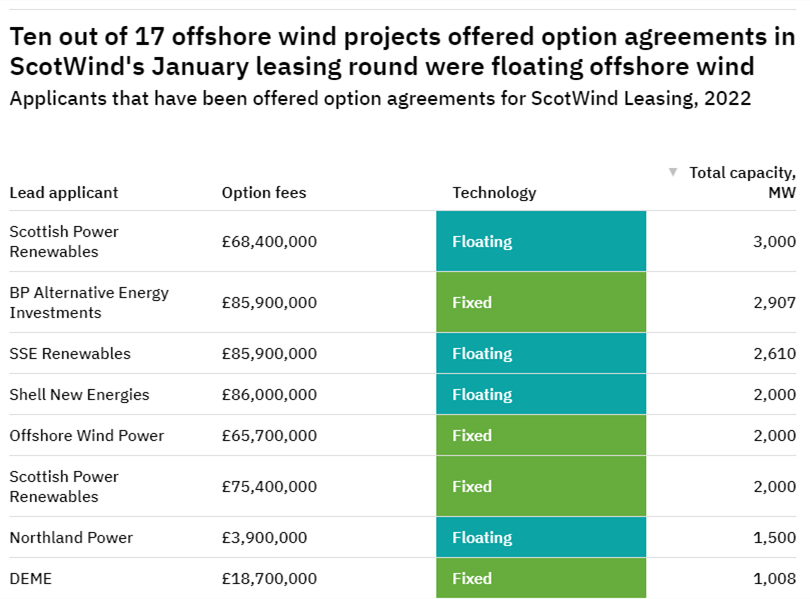
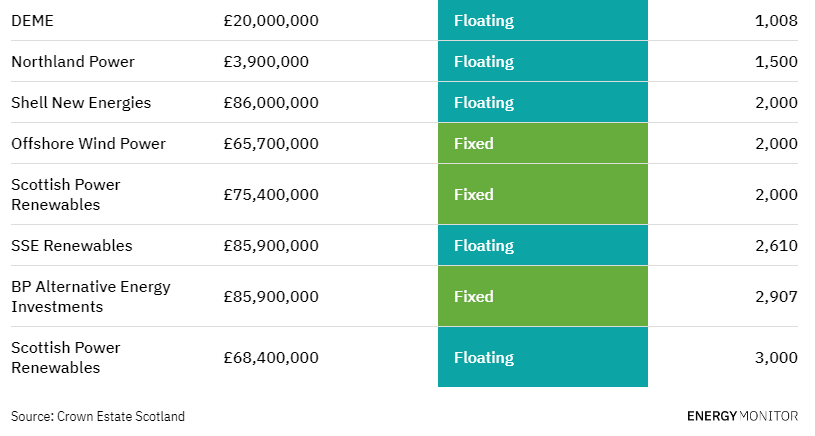
On the plus side, developing the supply chains needed for the 17 floating and fixed-bottom structures in the ScotWind leasing round will lead to £1.5bn per project being invested in Scotland, according to Crown Estate Scotland. “Crown Estate Scotland wrote-in quite stringent local supply chain requirements,” says Strivens.
Energy security crisis as an opportunity
Globally, the floating offshore wind pipeline already tops 50GW, according to RenewableUK analysis published last year. The UK remains the leader in terms of installed capacity, although a number of other countries including France, Ireland, Japan, Norway, Spain, and the US have floating ambitions.
Floating offshore wind could provide 2% of the world’s electricity by 2050, compared with 10% from fixed-bottom offshore, according to DNV’s forecasts. Equinor estimates it could power 12 million homes in Europe by 2030.
The UK Government has given strong signals in favour of floating wind as part of its large-scale push to scale up offshore wind. In January, it announced £31m in government funding for the technology, with Energy Minister Greg Hands noting that floating technology is “key to unlocking the full potential of the seas around Britain” and will “help to reduce our exposure to volatile global gas prices”. The recent energy security strategy referred to both fixed and floating offshore wind as recognised and dependable sources of energy, notes Strivens.
“Energy security, decarbonisation, and affordability are focusing the minds of policymakers like never before,” says Wyn Jones. “The pandemic brought about changes to work and business practices that might have taken another decade. I think the current energy security crisis in some ways might be having the same impact on the supply side of energy.”